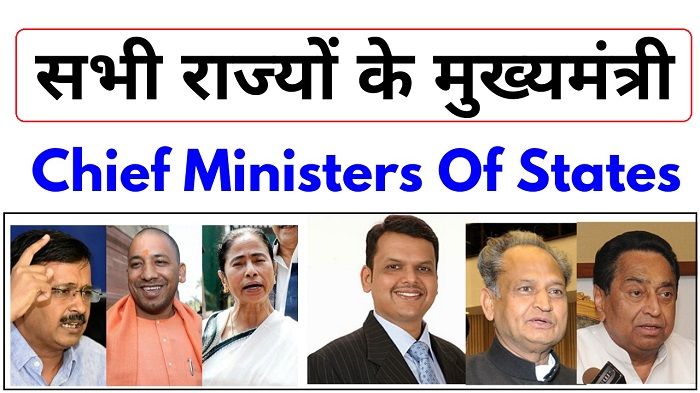In the Republic of India, each of the twenty-eight states and three of the eight union territories is headed by a chief minister. According to the Constitution of India, the Governor is the legal head at the state level, but the actual executive authority is the Chief Minister. After the state assembly elections, the governor usually invites the majority party (or coalition) to form the government. Governor appoints the Chief Minister Whose cabinet is collectively responsible to the assembly. If there is a vote of confidence in the Legislative Assembly, then the tenure of the Chief Minister is usually a maximum of five years; Apart from this, there is no limit to the number of tenures of the Chief Minister.
According to the Indian Constitution, in the parliamentary system of government, the real head of the state is the head of government. Just as there is the position of the Prime Minister at the Centre, similarly there is that of the Chief Minister in the state. Let us tell you that under Article 164 of the Constitution, the Chief Minister is appointed by the Governor in the state. This does not mean that the Governor is free to appoint any person as the Chief Minister.
In the parliamentary system, the governor appoints the leader of the majority party in the state assembly as the chief minister, but if no party gets a clear majority, the governor can exercise his discretion in the appointment of the chief minister. In such a situation, the Governor appoints the leader of the largest party or group of parties as the Chief Minister and asks him to take a vote of confidence in the House within a month.
Do you know that if the Chief Minister dies during the tenure and no successor is fixed, then the Governor can appoint the Chief Minister by his personal decision. India is a federal constitutional republic governed under a parliamentary system In which 28 states and 9 union territories are included. All the states have the Chief Minister as the head of the Legislative Assembly. Except for 2 states (Delhi and Puducherry), all union territories are governed by governors or head of state. So there are total 31 Chief Ministers. Here is the list of current Chief Ministers of Indian states. Let us study through this article.
List of Current Indian Chief Ministers
|
State |
Name |
Party |
|
Andhra Pradesh |
Y. S. Jagan Mohan Reddy |
YCP |
|
Arunachal Pradesh |
Pema Khandu |
BJP |
|
Assam |
Himanta Biswa Sarma |
BJP |
|
Bihar |
Nitish Kumar |
JD |
|
Chhattisgarh |
Bhupesh Baghel |
INC |
|
Delhi[b] |
Arvind Kejriwal |
AAP |
|
Goa |
Pramod Sawant |
BJP |
|
Gujarat |
Bhupendrabhai Patel |
BJP |
|
Haryana |
Manohar Lal Khattar |
BJP |
|
Himachal Pradesh |
Jai Ram Thakur |
BJP |
|
Jammu and Kashmir |
Vacant |
- |
|
Jharkhand |
Hemant Soren |
JMM |
|
Karnataka |
Basavaraj Bommai |
BJP |
|
Kerala |
Pinarayi Vijayan |
CPM |
|
Madhya Pradesh |
Shivraj Singh Chouhan |
BJP |
|
Maharashtra |
Uddhav Thackeray |
Shiv Sena |
|
Manipur |
Nongthombam Biren Singh |
BJP |
|
Meghalaya |
Conrad Sangma |
NPP |
|
Mizoram |
Zoramthanga |
MNF |
|
Nagaland |
Neiphiu Rio |
NDPP |
|
Odisha |
Naveen Patnaik |
BJD |
|
Puducherry[b] |
Nadesan Rangaswamy |
AINRC |
|
Punjab |
Bhagwant Mann |
AAP |
|
Rajasthan |
Ashok Gehlot |
INC |
|
Sikkim |
Prem Singh Tamang |
SKM |
|
Tamil Nadu |
M. K. Stalin |
DMK |
|
Telangana |
Kalvakuntla Chandrasekhar
Rao |
TRS |
|
Tripura |
Biplab Kumar Deb |
BJP |
|
Uttar Pradesh |
Yogi Adityanath |
BJP |
|
Uttarakhand |
Pushkar Singh Dhami |
BJP |
|
West Bengal |
Mamata Banerjee |
AITC |


